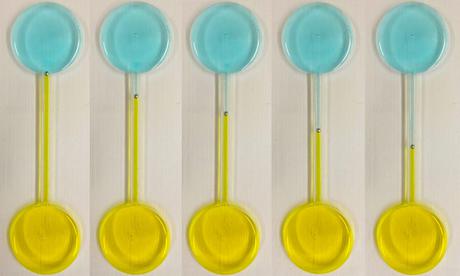Australian researchers create self-propelling liquid metals

RMIT researchers have created self-propelling liquid metals — the very stuff the T-1000 Terminator was made of. While a shape-shifting android assassin is still situated firmly in the realm of imagination, the development is a critical step in moving from solid-state electronics towards flexible and dynamically reconfigurable soft circuit systems.
Researchers dream of creating truly elastic electronic components — soft circuit systems that can act more like live cells, moving around autonomously and communicating with each other to form new circuits rather than being stuck in one configuration.
Liquid metals, in particular non-toxic alloys of gallium, have so far offered the most promising path for realising that dream.
As well as being incredibly malleable, any droplet of liquid metal contains a highly conductive metallic core and an atomically thin semiconducting oxide skin — all the essentials needed for making electronic circuits.
To work out how to enable liquid metal to move autonomously, Professor Kourosh Kalantar-Zadeh and his group from the School of Engineering at RMIT first immersed liquid metal droplets in water.
“Putting droplets in another liquid with an ionic content can be used for breaking symmetry across them and allow them to move about freely in three dimensions, but so far we have not understood the fundamentals of how liquid metal interacts with surrounding fluid,” Kalantar-Zadeh said.
“We adjusted the concentrations of acid, base and salt components in the water and investigated the effect.
“Simply tweaking the water’s chemistry made the liquid metal droplets move and change shape, without any need for external mechanical, electronic or optical stimulants.
“Using this discovery, we were able to create moving objects, switches and pumps that could operate autonomously — self-propelling liquid metals driven by the composition of the surrounding fluid.”
The research lays the foundation for being able to use ‘electronic’ liquid metals to make 3D electronic displays and components on demand, and create makeshift and floating electronics.
“Eventually, using the fundamentals of this discovery, it may be possible to build a 3D liquid metal humanoid on demand — like the T-1000 Terminator but with better programming,” Kalantar-Zadeh said.
The research, which has potential applications in a range of industries including smart engineering solutions and biomedicine, is published in Nature Communications.
In the paper, first author Dr Ali Zavabeti detailed the precise conditions in which liquid metals can be moved or stretched, how fluid on their surfaces moves around and, as a result, how they can make different flows.
The work also explains how the electric charges that accumulate on the surface of liquid metal droplets, together with their oxide skin, can be manipulated and used.
A lighter, smarter magnetoreceptive electronic skin
Researchers have developed an innovative e-skin that facilitates a new level of interaction...
Single transistor used to implement neuromorphic behaviour
Researchers have demonstrated that a single transistor can mimic neural and synaptic behaviours,...
Novel fabrication technique for flexible electronics
Researchers have harnessed nature's intrinsic hierarchical fractal structures to improve the...





